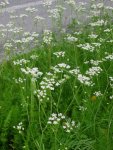Cumin
Carum carvi L.
Botanical characteristics. Family umbrella. A biennial herbaceous plant with a hollow stem hollow from inside with a height of up to 1 m. In the first year the plant forms only a root rosette of leaves, the stem appears in the second year. Leaves are regular, gradually decreasing to the apex. Small white flowers are collected on tops of stems in a complex umbrella. Blossoms in May-June. Fruits - two-parted achenes, ripen in July-August.
Spread. In the wild, common in the European part of Russia, in Siberia, in the Far East, is found in Central Asia. It grows on dry forest glades, in the fields, near roads. Cultivated as a food and medicinal plant.
Used parts of the plant.
Fruit.
In fruits of cumin contains essential oil (from 3 to 7%), consisting mainly of carvones and limonene; Tannins and fatty oil (up to 22%). Flavonoids (quercetin, kaempferol and isoramnetin) and acetylenic compounds - polyins are distinguished from flowers and grass.
Application. Cumin excites appetite, promotes digestion, acts spasmolytic (on the musculature of the intestines, uterus, ureters, bladder), strengthens the secretion of bronchi, increases lactation. In folk medicine, cumin is taken as an expectorant for bronchitis, and as an analgesic, laxative and carminative agent for gastritis, enterocolitis, intestinal colic in children, flatulence, chronic atonic constipation. It is recommended to enhance the production of milk in nursing mothers.
Preparation.
Infusion: 2-3 teaspoons cumin insist in 200 ml of boiling water (preferably in a thermos) - taken during the day.
Folk recipe: 1 tablespoon fruit per one glass of sour cream; Boil for 3 minutes. Take 1 tablespoon 3 times a day with breastfeeding to enhance lactation (AI Popov).




Comments
When commenting on, remember that the content and tone of your message can hurt the feelings of real people, show respect and tolerance to your interlocutors even if you do not share their opinion, your behavior in the conditions of freedom of expression and anonymity provided by the Internet, changes Not only virtual, but also the real world. All comments are hidden from the index, spam is controlled.